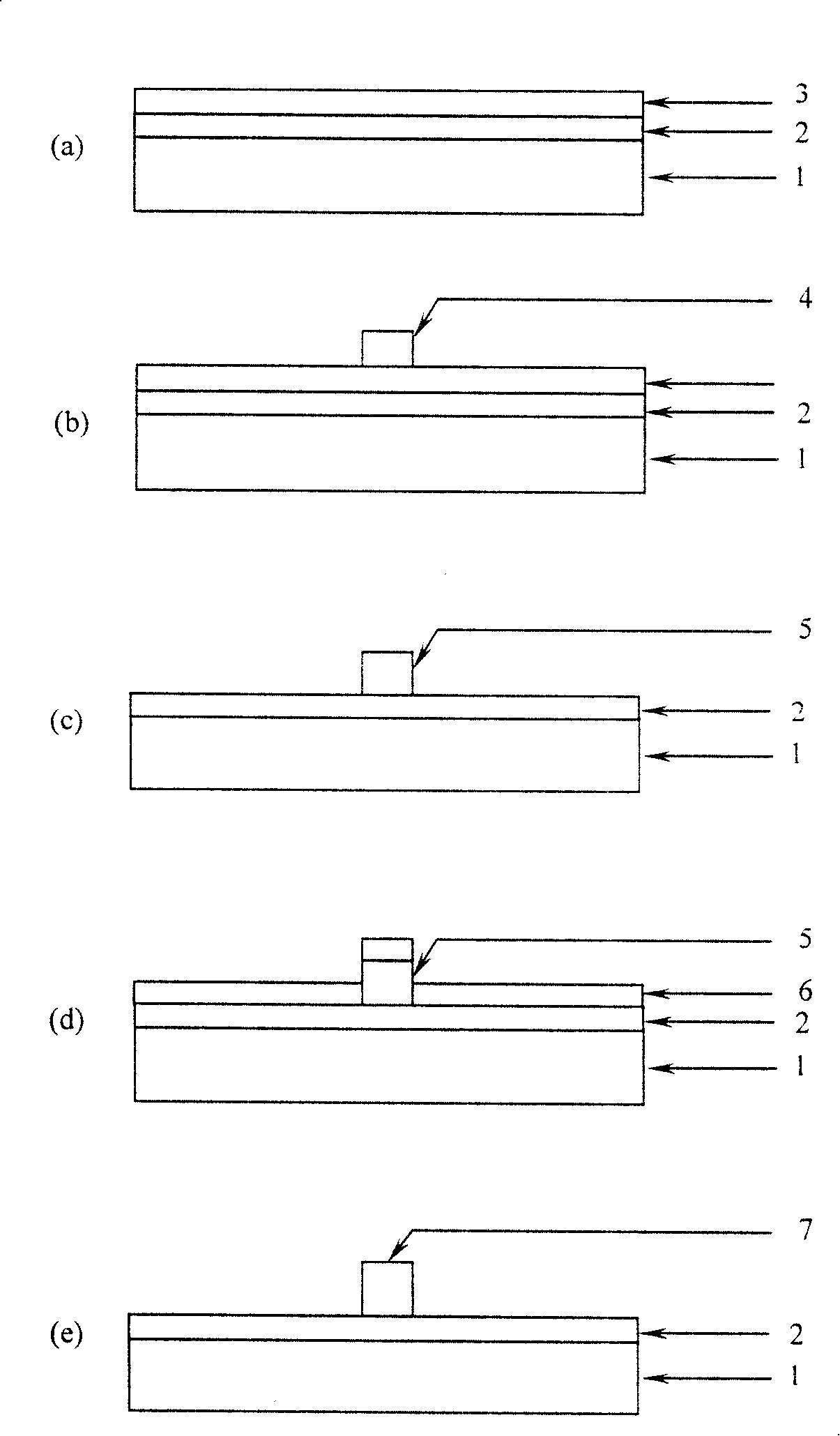Material with metal silicide nanostructure and method for making the same
A technology of metal silicide and nanostructure, applied in semiconductor/solid-state device manufacturing, electrical components, electrical solid-state devices, etc., can solve the problems of difficult control of size, shape and growth position, achieve low power consumption and eliminate latch-up effect , The effect of simple production process
- Summary
- Abstract
- Description
- Claims
- Application Information
AI Technical Summary
Problems solved by technology
Method used
Image
Examples
Embodiment 1
[0046] refer to figure 1 , make the nickel silicide nanostructure of this embodiment according to the flow process of the present invention:
[0047] 1) Select an SOI substrate with a thin layer of single crystal silicon prepared by oxygen injection isolation technology, and its crystal orientation is (100). The SOI substrate consists of an insulating dielectric interlayer 2 grown on a single crystal silicon wafer 1 and a top silicon Composed of thin film 3; the top silicon thin film 3 is monocrystalline silicon, its thickness is 100 nanometers, and the thickness of insulating medium interlayer 2 is 350 nanometers;
[0048] 2) After the SOI substrate described in step 1) is washed and dried with acetone, alcohol and deionized water, spin-coat the positive photoresist PMMA, and pre-bake it on a hot plate at 180 ° C for 1 minute. The thickness of the resist is about 100 nanometers, and the Raith 150 electron beam exposure system is used to directly write two rectangular pattern...
Embodiment 2
[0054] For the nickel silicide nanostructure prepared in this embodiment, see figure 2 , the width of the nickel silicide line shown in the figure is 280 nm.
[0055] refer to figure 1 , the preparation method of this example is according to figure 1 The technological process is carried out, and the detailed description is as follows:
[0056] 1) Spin-coat HSQ solution on a single crystal silicon substrate (single crystal silicon support layer 1), bake at 250°C for 2 minutes, and form an HSQ insulating dielectric interlayer 2 with a thickness of about 150 nanometers, and then use magnetron sputtering Thin layer of polysilicon is spray-deposited with a thickness of about 80 nanometers to form an SOI substrate
[0057] 2) Spin-coat the negative photoresist (SAL 601) on the SOI substrate prepared in step 1), and pre-bake it on a hot plate at 105°C for 2 minutes. The exposure system exposes a series of lines with a length of 100 microns and a width of 250 nanometers, post-bak...
Embodiment 3
[0063] refer to figure 1 , the technical process of making titanium disilicide nanostructure in this embodiment is according to figure 1 As shown, the specific steps are as follows:
[0064] 1) Select an SOI substrate with a thin single crystal silicon layer prepared by oxygen injection isolation technology, its crystal orientation is (100), the thickness of the top silicon layer is reduced to 50 nanometers after reactive ion etching, and the silicon oxide buried layer The thickness is 350 nm.
[0065] 2) Spin-coat the positive photoresist PMMA on the SOI substrate thinned in step 1), bake at 180°C for 1 minute, the thickness of the photoresist is about 100 nanometers, and put it into a Raith 150 electron beam exposure system for exposure. The pattern design is a square array with a side length of 4.9 micrometers and a period of 5.0 micrometers, which leaves mutually orthogonal lines with a width of about 100 nanometers after exposure. After developing and fixing, the phot...
PUM
| Property | Measurement | Unit |
|---|---|---|
| thickness | aaaaa | aaaaa |
| thickness | aaaaa | aaaaa |
| thickness | aaaaa | aaaaa |
Abstract
Description
Claims
Application Information
 Login to View More
Login to View More - R&D
- Intellectual Property
- Life Sciences
- Materials
- Tech Scout
- Unparalleled Data Quality
- Higher Quality Content
- 60% Fewer Hallucinations
Browse by: Latest US Patents, China's latest patents, Technical Efficacy Thesaurus, Application Domain, Technology Topic, Popular Technical Reports.
© 2025 PatSnap. All rights reserved.Legal|Privacy policy|Modern Slavery Act Transparency Statement|Sitemap|About US| Contact US: help@patsnap.com


